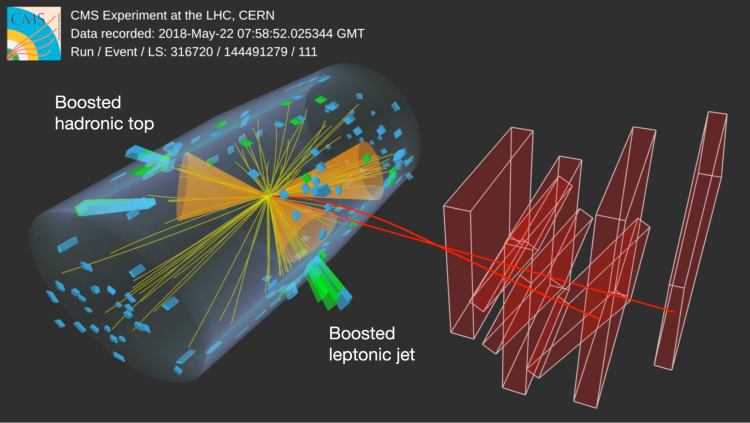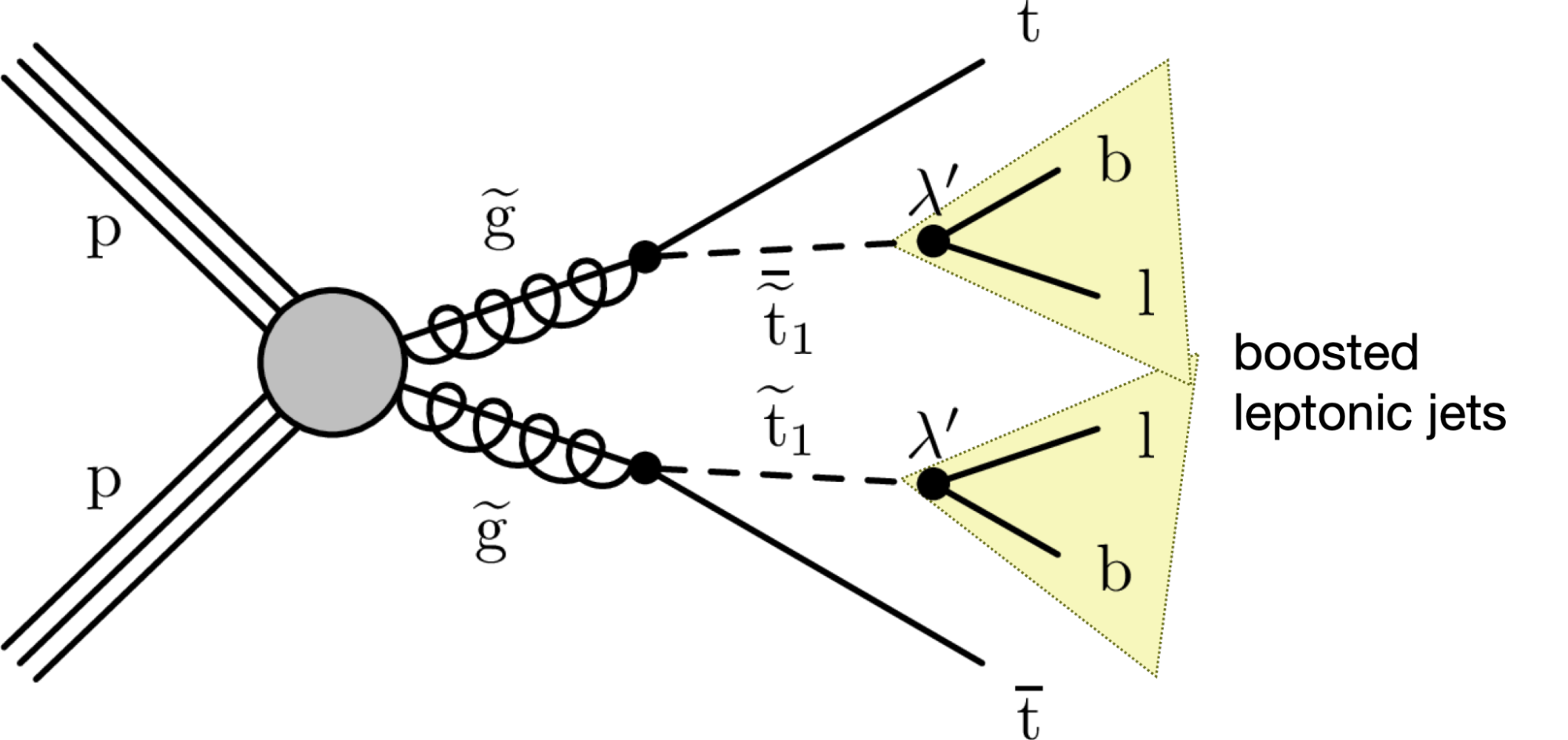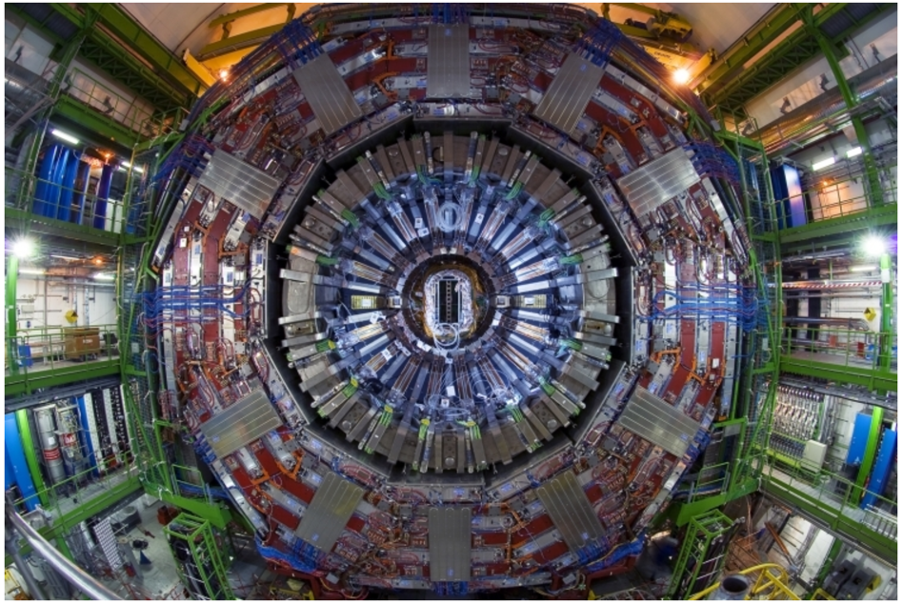
The CMS collaboration expands the search for supersymmetry by exploring a wide variety of final states with boosted particles, in a new analysis called “razor boost”.
Supersymmetry, or SUSY, which suggests that every known particle has a new, heavier partner superparticle, remains one of the most compelling and comprehensive candidate models to extend the standard model. But SUSY doesn’t come with a clear instruction manual: these superparticles could have all kinds of masses and patterns of decaying into lighter particles, which manifest as unique final states composed of a rich variety of particle combinations. To thoroughly explore this theory, we search across a broad spectrum of final states, aiming to uncover any possible signs of SUSY.
One class of final states arises when a superparticle is much heavier than the particles it decays into. In such cases, a significant portion of the heavy particle’s mass is converted into the motion of the lighter particles, giving them a substantial boost in momentum – an effect known as a Lorentz boost. If these Lorentz-boosted particles also decay, their decay products will follow paths that are close together in space. In our detectors, this appears as two or more distinguishable particles merging into a single, larger structure, which we call a boosted object. The larger the mass difference, the greater the boost. So, exploring final states with boosted objects allows us to probe superparticles with higher masses.
Previous SUSY searches have explored boosted objects, but typically focused on very specific final states. We have recently developed an analysis that takes a much broader approach and explores SUSY in a wide range of final states containing all kinds of boosted particles: boosted W, Z, and Higgs bosons, as well as boosted top quarks. These standard model particles can appear in the decays of heavy supersymmetric particles such as gluinos, squarks, charginos, and neutralinos: the superpartners of gluons, quarks, and a mixture of W/Z/Higgs bosons and photons, respectively. To efficiently identify these well-defined particles with known masses in the case where they decay into quarks, CMS employs advanced machine learning algorithms that search for large jets (collimated sprays of particles) containing smaller jets inside: a characteristic signature of boosted objects.
Moreover, for the first time, we explored SUSY final states containing both quarks and leptons that become spatially merged – boosted leptonic jets. Overall, we examined 25 unique and statistically disjoint final states with varying combinations of boosted object types, jets, b-quark jets, and leptons. For each final state, we analyzed the distributions of the so-called razor kinematic variables, which cleverly apply the rules of relativistic physics to construct quantities where a SUSY signal, with heavy superparticles, would appear as a clear bump on top of the smoothly falling background from standard model processes.

Above: Diagram showing a new physics process explored in this analysis. Two protons collide, and lead to two gluinos, each decaying to a top quark and a top squark. Top squarks subsequently each decay into a lepton and a b quark. When the top squark has a high momentum, its decay products travel spatially close, and form a boosted leptonic jet.
The statistical analysis to the fit in data showed no significant deviations compared to standard model predictions. We used this agreement to set very strong upper limits on superparticle production rates and masses in eight simple SUSY simplified models, defined by idealized production and decay mechanisms involving only two or three superparticles.
But razor boost’s journey is not over. The 25 distinct final states examined here provide the necessary breadth to interpret results beyond simplified models, in complete SUSY models, which account for the full spectrum of superparticles and a realistic variety of production and decay processes. For example, different final states we explore provide sensitivity to different decay modes of a superparticle, and their combined impact will lead to stronger constraints on such realistic models. This broader interpretation is now underway, extending the reach of this search across the full landscape of SUSY, helping to clarify our understanding of this compelling theory.
Written by: Sezen Sekmen, for the CMS Collaboration
Edited by: Muhammad Ansar Iqbal
Read more about these results:
-
CMS Physics Analysis Summary (SUS-23-014): "Search for supersymmetry in hadronic and leptonic final states with highly Lorentz-boosted objects at √s = 13 TeV"
-
@CMSExperiment on social media: Bluesky - Facebook - Instagram - LinkedIn - TikTok - Twitter/X - YouTube

